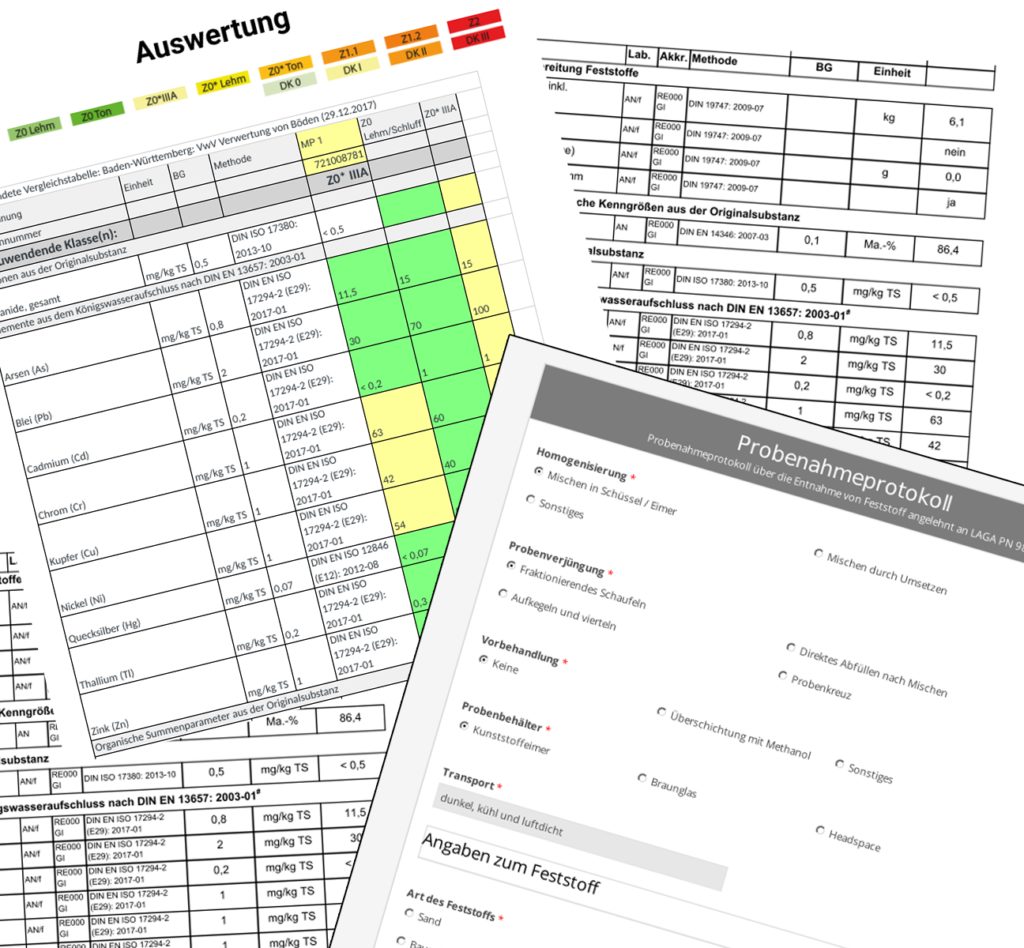Our declaration analysis will tell you whether there are any pollutants in your soil. This is the basis for the proper disposal of excavated soil.
Declaration analysis

Our declaration analysis will tell you whether there are any pollutants in your soil. This is the basis for the proper disposal of excavated soil.
Declaration analysis
simply explained
Sampling
During sampling, our sampler takes a soil sample. The sampling is planned in advance by our sampler on the basis of available documents and any previous knowledge of the soil. The planning of the sample and the analysis strategy are decisive for a meaningful declaration analysis.
Sampling is usually carried out in accordance with LAGA PN98. This is the regulation of the Länderarbeitsgemeinschaft Abfall at national level. It regulates the taking of samples from solids.
Sampling is documented in a sampling protocol. The sampling log shows any foreign matter, the storage type or possible sources of error that may be responsible for an inconclusive result of the declaration analysis.


Laboratory analysis
The laboratory analysis is the actual core of the declaration analysis. Before the soil material is analysed, the sample is prepared.
Sample preparation and most other procedures during the analysis are subject to precisely defined specifications, which are laid down in standards.
After sample preparation, the values of the defined parameters are measured using various methods. The result of each measured parameter is listed in a laboratory report, even if it was ultimately undetectable.
The laboratory report with the results of the individual parameters is essential for a waste declaration analysis.
Evaluation
The evaluation is a comparison of the actual measured values of individual parameters and the limit values of the underlying regulation.
If a limit value of an allocation class is exceeded, the entire floor is categorised in the next higher allocation class.
The evaluation immediately shows the disposal company which class is involved. It is part of a complete declaration analysis.

Declaration analysis
short and sweet
- What does a declaration analysis cost?
A declaration analysis costs between €500 and €1,000.
The amount of the costs depends on the scope of the parameters to be checked and the urgency.
The parameters to be checked depend largely on the federal state or the planned disposal route.
Once the disposal route has been determined, costs for the declaration analysis can be reduced by only testing the parameters that are actually relevant for the disposal site.
- What is a declaration analysis?
A declaration analysis provides information about the chemical contamination. It is often also referred to as a geochemical report or a waste law report.
In a declaration analysis, all parameters defined in the previously specified standard or regulation are analysed. Each regulation specifies different parameters whose values are to be analysed. The value of a parameter is often analysed both in the solid and in the eluate. Non-soluble elements are analysed in the solid, while the soluble elements are tested in the eluate. Once the individual values have been analysed, the results are compared with the limit values of the relevant regulation. Most regulations contain several classes with different limit values. During the evaluation, the measured values are compared with the limit values of the respective classes, whereby the actual classification takes place. The result of the evaluation is a classification of the waste in accordance with waste legislation.
- What is a declaration analysis needed for?
A declaration analysis for the waste classification of excavated earth is usually required for disposal. The waste classification enables the disposal company to ensure that the excavated soil is disposed of properly. Based on the sampling protocol, laboratory analysis and evaluation, the disposal company can check which disposal centres are suitable for the disposal of excavated soil. In return, each disposal site has a licence with limit values to be complied with. The disposal centre must ensure that only suitable soil is delivered whose values do not exceed the limit values. To ensure this, the disposal centres require the submission of a declaration analysis with sampling protocol and evaluation or waste classification.
- According to which regulation is my excavated soil to be analysed?
The regulation according to which the excavated soil is to be analysed depends largely on the disposal route. The disposal method in turn depends largely on the results of the declaration analysis. In most cases, each federal state has its own regulations for the disposal of excavated soil. However, there are also disposal routes that are based on a national regulation. Unfortunately, it is not always possible to give a definitive answer at this point.
We will be happy to give you a well-founded recommendation with regard to possible disposal methods!
- When should a declaration analysis be carried out?
The declaration analysis should not be older than 6 months at the time of disposal of the excavated soil!
When disposing of 0-1000m³ of excavated earth, it is advisable to carry out a declaration analysis 6-8 weeks before the excavation. This leaves enough time to organise a disposal route. At the same time, there is sufficient buffer to ensure that the deadline of 6 months is not exceeded in the event of delays.
For construction projects over 1000m² of excavated earth, it may make sense to carry out a preliminary geochemical investigation well before the excavation of the building pit in order to have possible disposal routes ready. The disposal of large quantities of excavated earth usually requires a longer lead time and planning in view of the limited capacities.
A preliminary investigation by means of a declaration analysis is also recommended before purchasing a plot of land in order to avoid unexpectedly high costs when disposing of the excavated soil.
Whether the declaration analysis can be sampled before the actual excavation or whether a pile must first be formed for sampling the excavated soil when excavating the construction pit depends on the individual case. This largely depends on previous knowledge of the soil. For example, a subsoil expertise can provide information about any backfilling or homogeneity. Soil can also be taken for preliminary geochemical exploration when sampling the subsoil expertise.
- What needs to be considered when analysing declarations?
- It should always be commissioned with a sampling protocol with image documentation, a laboratory analysis and an evaluation.
- Sampling should be carried out by a sampler with a certificate of technical and professional suitability in accordance with LAGA PN98.
- The laboratory analysis should be carried out by an accredited laboratory.
- It should not be older than 6 months at the time of disposal.
Tip: For large construction projects, high costs can be avoided with a good analysis strategy!
